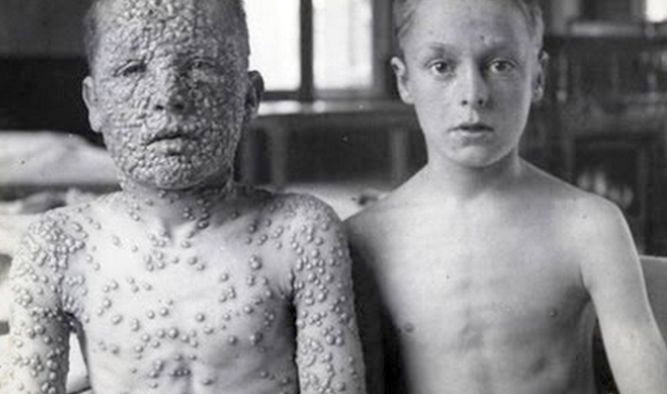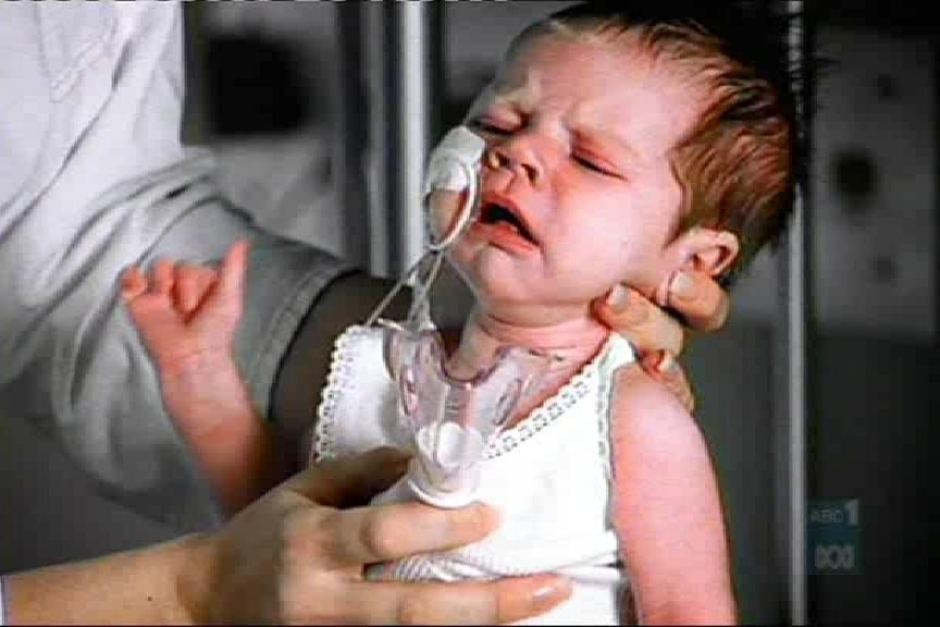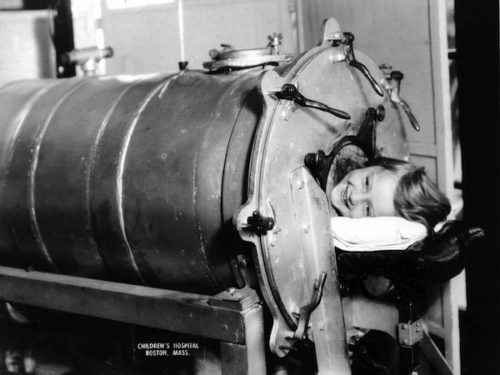Immunization v. Vaccination: A Story of Gullibility, Fear, Despicable Avarice and Scams
If you’re like me, all this hysteria about immunizations is a bit hard to comprehend let alone understand. My very early memories concerning health were about friends and classmates becoming crippled and dying of polio and mumps and measles and whooping cough!
I remember taking cans around to collect “pennies by the inch” and news stories about children all over the nation sending dimes to the president and the “children’s March of Dimes.” Why were we so fearful, so troubled, so united, so focused? Were we all stupid? Deluded? Conned? Was it all a myth?
Vintage photo of young girl stricken with polio living in an iron lung
Now, we’ve got haters all over calling the life-saving, community-protecting, child-guarding things we accomplished worthless and even harmful. They’re even deliberately trying to sway us away from using our hard-won, long-proven word: “immunization” into using the harsh-sounding word, “vaccination,” to subtly convey fear and danger every time we talk about it.
For me, I remember seeing quarantine signs on people’s doors—now that was fear! I’ve actually seen iron lungs used for children stricken with polio… have you? And I’ve seen the tiny toys inside them held as security by the last child resident of the machine—that was real fear.
How did this happen? Was all that for nothing? Are we going backward?
Immunization: How Did We Get Here
Fear, Gullibility, Avarice and Scams
We have centuries worth of experience and data giving irrefutable evidence of the benefits of immunizations. Millions upon millions of deaths have been prevented with demonstrated proof that it was immunization programs which accomplished it. Do we throw all that experience out the window?
A cottage industry of vaccine-haters seems to win converts and come ever onward. The numbers make some of us in the trenches wonder how otherwise seemingly rational parents make decisions which are clearly not in the best interest of their children—fear? gullibility? avarice?
I know of a pediatrician who carried his questioning into the trenches with him and actually immersed himself in the life of a vaccine-hater. For a solid month he read all he could from the anti-vaccine cottage industry. Their literature, their claims, their meetings. Thirty days worth of their rhetoric and doctrine in order to try and understand the parents of the children he was trying to care for.
That also led him into understanding the history of immunizations, their problems, their solutions and how the multi-million dollar vaccine-hater cottage-industry was born. And he came up with the 10 reasons parents most often use when deciding to delay or not immunize their children.
Immunization: Discovery and Invention

Immunizations, as we know them, began with the body-destroying plague of Smallpox ruining the lives of families all over the world; and a related disease “Cowpox” decimating cattle herds.
As usual, those actually in the trenches with the disease noticed it first: those who contracted the cowpox from cattle and survived, almost never caught the Smallpox when they were exposed. And a British clergyman’s son, Dr. Edward Jenner, paid enough attention to them that he began researching the link to try and discover a way to give everyone immunity.
That led to purifying (as best as could be at the time) material from cowpox and inoculating a “street child”—who most certainly and continually risked exposure to smallpox on the streets. Fortunately, for all of us, experimentation standards have changed since then; but, from that beginning, the disease Smallpox was literally wiped from the face of the earth and immunization methods have advanced considerably.
But merely saying: “the rest is history” would be a total and complete understatement and reckless. IT WAS NOT A SLAM DUNK BY ANY STRETCH OF THE IMAGINATION! The hotsy-totsy Royal Society of Physicians rejected Jenner and his findings with VENOMOUS VEHEMENCE!—leaving it to a lone American physician, Dr. Benjamin Waterhouse, to believe, replicate it on his own son and save not only him from Smallpox but countless others as well.
At final last, humanity had some hope of victory over the scourges which regularly wiped out whole populations and destroyed lives and families. You may think that the Wright Brothers did some pretty great stuff by inventing the airplane; but, to many of us medical types, the use of routine childhood immunizations was the greatest single triumph of the twentieth century—even edging out the discovery of Penicillin.
Millions upon millions would have been paralyzed by Polio, died from meningitis, tetanus, pneumonia or whooping cough, become neurologically devastated by measles, battled cancer of the cervix or liver, been ravaged by Smallpox or lived with the horrors of congenital rubella.
The tendency toward suspicion about anything new, including immunizations, is nothing new and is readily capitalized upon by those either making or loosing MONEY on the endeavor—think tobacco industry, major-league football. The more the money the greater and more deadly the attacks on those fighting the battle.
Over a hundred years after Jenner, in 1910, the great Sir William Osler, the father of modern medicine, was so overcome with frustration over trying to deal with the vaccine-hater faction of the time that he offered to take ten vaccinated and ten unvaccinated people with him into a smallpox epidemic. AND promised to care for the latter when they succumbed to the disease AND offered to provide financially for their funerals! (NEJM, 1/13/2011)
DPT Immunizations

Gradually over a century, the benefits of immunization programs became clear in most people’s minds. Other diseases too began to fall to an immunization; and, for the first time, most parents began raising a family without one of their children dying. Then came a poorly designed statistical study leading to false conclusions which stirred it all up again.
Pertussis, called Whooping Cough, is a highly, highly contagious and frequently deadly disease caused by a bacteria—particularly dangerous in the first year of life and to toddlers. No one who has ever watched a baby frantically clawing for air with pertussis can ever forget it; which, is the problem because as immunizations do their job, fewer and fewer people actually gain the perspective.
The organism is so ubiquitous and contagious that immunization needs to be begun at the earliest possible time an infant’s immune system can respond: two months. During the first two months a baby has fought off most illnesses by using antibodies transferred from its mother before birth; so most often has not even had a fever.
When it was first developed, the Pertussis vaccine was a weakened form of the bacteria which didn’t cause the disease but was “whole cell” so it was quite antigenic. About one in five infants developed a fever the day of injection, for some their first ever fever. Additionally, a very small number of those had a febrile seizure if their temperature went up too rapidly. The “reaction” was only temporary.
For those who had seen a child with the actual disease, the side-effects didn’t dissuade; but, for those first-time parents whose only experience with an ill child so far in their lives was a “reaction” to a baby shot, it was quite disquieting—which eventually led to a huge improvement in the way the immunization is made.
The new acellular immunization has none of the previous side effects (perhaps the only good thing to come out of this mess)—but… alas… the association with adverse reactions was back in parent’s minds.
12 Posts in Immunizations (immunizationSafety) Series
- The vaccine strategy (video) – 20 Jun 2017
- 10 reasons parents choose not to immunize – 6 Jun 2017
- Immunization v. Vaccination: Vaccine-Hater Cottage Industry – 31 May 2017
- Immunization v. Vaccination: How we got in this mess – 27 May 2017
- Vaccine-preventable diseases coming back – 30 Apr 2017
- Return of Measles Disease – 22 Jun 2015
- Decision not to immunize nearly killed their son – 11 Jun 2015
- Measles Outbreak in unvaccinated – 18 May 2014
- Autism and Immunization Link Debunked... Again – 30 Mar 2013
- Immunization Safety Research – 30 Jan 2013
- Wakefield Immunization Fraud – 29 Jan 2013
- Immunization Safety Series: Intro/Index – 28 Jan 2012
Advertisement by Google
(sorry, only few pages have ads)

